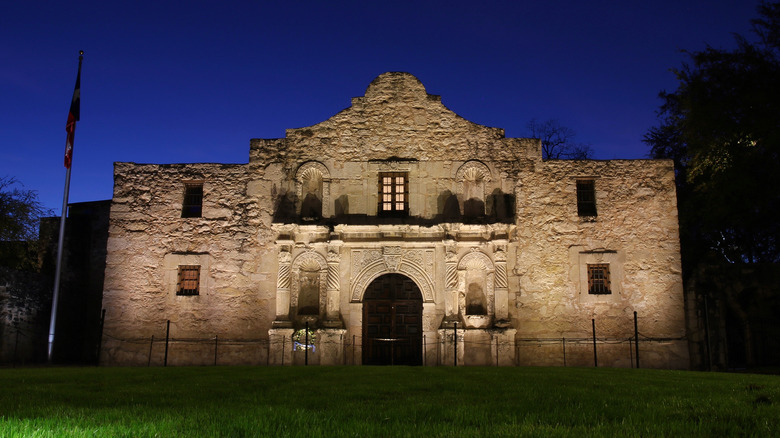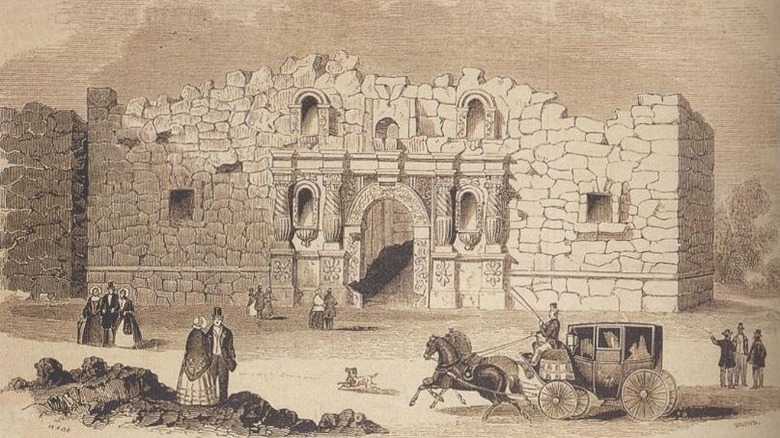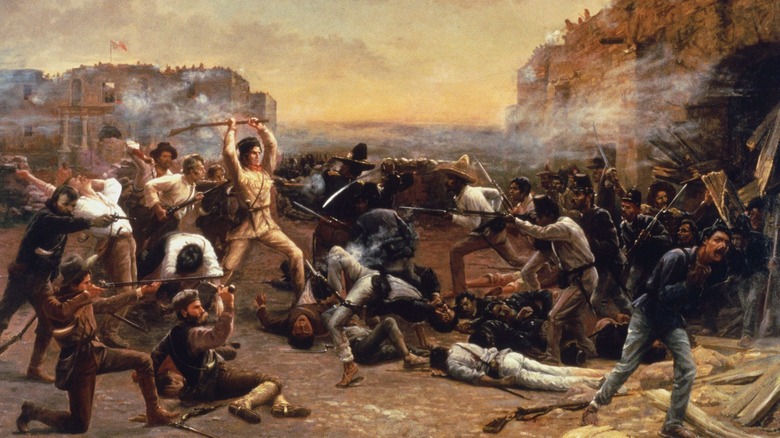This Is What The Battle Of The Alamo Was Really About
By any standards, the 1836 Battle of The Alamo wasn't even the biggest fight during the Texas Revolution. But the taking of the Alamo fortress and the deaths of everybody fighting to defend it directly lead to the end of the entire conflict.
Back then, Texas belonged to Mexico, but was fighting to break away, fueled by groups of U.S. colonists and Tejanos (Texas Mexicans) resisting the Mexican unitary political regime. Part of the Mexican government's path to centralization was limiting the rights of its citizens and controlling immigration coming from the United States. As part of that fight, the Tornel Decree was passed to declare any rebels as enemies of Mexico and make clear that foreigners fighting against Mexican troops "will be deemed pirates and dealt with as such, being citizens of no nation presently at war with the Republic and fighting under no recognized flag" (via StoryMap).
Unfortunately for the Alamo, Mexican President Antonio López de Santa Anna had no sympathy for any kind of insurrection. So when he made a plan to march into Texas to reclaim the land and "clean" the state of rebels, the Alamo simply stood in the way.
The siege and subsequent Battle of the Alamo lasted for 13 days — a lot longer than anybody expected the garrison of the Alamo to survive. To Santa Anna, it probably felt like a great victory, but the bloody battle actually inspired many Texians and Tejanos to join the rebellion and fight harder, according to Britannica.
The deeper reasons behind The Alamo's bloody battle
The Texas Revolution was a direct response to Mexico's 1835 constitutional changes, which were intended to give the government more centralized power, including controlling immigration and import tariffs. The laws particularly targeted immigrants (both legal and illegal) who lived on the border of Mexican Texas. Santa Anna believed they were to blame for the unrest in the area, and was determined to quell the rebellion (per Britannica).
Things didn't start well for the Mexican troops, though, as they lost the first official battle of the Texas Revolution in early October and were forced to retreat. The Texan revolutionary army went on to win several other battles, including one on November 26 now known as the "Grass Fight," which was triggered by mules carrying grass feed for Mexican horses. By December, however, Mexican forces had taken over the Alamo mission and the nearby town. That is, until Texans began a formidable coordinated house-to-house assault that ended up with the Mexican forces withdrawing, according to Britannica. It's fair to say that Santa Anna was, at this point, very unhappy.
He spent the next few months planning and executing a plan to punish the rebels, which included marching towards San Antonio de Béxar, where the small outpost of the Alamo was located. Formerly part of the Spanish Missions, the Alamo had been used as a fortress since the early 1800s, but it lacked true defensive features against artillery (via World Heritage). When Santa Anna's troops arrived, they expected a quick and easy victory.
The men at The Alamo could have avoided the fight
When news arrived that Mexican troops were marching towards the Alamo, the garrison's commander asked for reinforcements, supplies, and ammunition. When they received nothing, The Alamo's co-commander, James Bowie, then wrote a letter to the Governor, explaining that "the salvation of Texas depends in great measure on keeping Béxar out of the hands of the enemy ... If it were in the possession of Santa Anna, there is no stronghold from which to repel him in his march towards the Sabine [River]" (via The Alamo).
By February, frontiersman David Crockett and other volunteers had arrived. The garrison numbered around 200. At this point, Sam Houston, Commander-in-Chief of the Texas army, told Bowie it made more sense to abandon the Alamo, but according to History, the soldiers and volunteers at the mission chose to stay and make a stand. A Mexican force of over several thousand men arrived at the Alamo on February 23 and a 13-day long siege ensued. On the morning of March 6, the Mexican forces began their assault. Women, children, and slaves were spared; all of the defenders were killed.
The news of what happened at the Alamo spread quickly and enraged colonists and Texian soldiers, who planned a surprise attack on Santa Anna's camp. According to History, on April 21, 800 Texian soldiers overtook a camp double their size with the rallying cry of "Remember the Alamo!" As a result of this defeat at San Jacinto, Santa Anna was forced to remove his troops from Texas.


